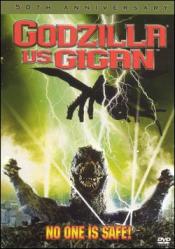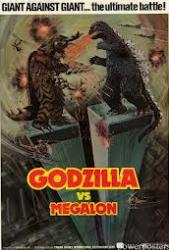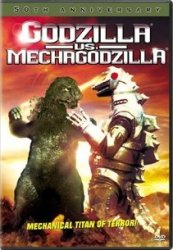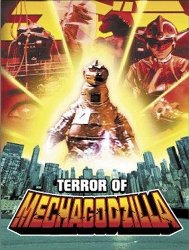Godzilla vs. Gigan (1972) ![]()
Godzilla vs. Megalon (1973) ![]()
Godzilla vs. Mechagodzilla (1974) ![]()
Terror of Mechagodzilla (1975) ![]()
Four films, one synopsis: Aliens–wacky inept aliens–plan to take over the world in the most logical fashion: using giant monsters. Why use advanced weaponry when you can use over-sized bipedal critters? Godzilla, the atomic destroyer and all around swell lizard, is ready to fight off the threat and save Japan, but as he is being double-teamed, he needs the help of the most unlikely ally imaginable. Meanwhile, humans, some of them government agents, run around, get shot, get taken prisoner, and escape, all of which amounts to nothing but takes up a great deal of time.
By 1970, Godzilla had shifted from a metaphor for the horror of the atom bomb, through towering adventure film villain, to cheesy savior of Japan. The franchise had dipped to a spectacular low with Godzilla’s Revenge, a juvenile clip film, and the ’70s would offer only more of the same. No longer aimed anywhere near adults, the ’70s movies were children’s films that assumed kids were mentally deficient chimps. Well, four of them were. 1971s Godzilla vs. The Smog Monster is a psychedelic trip best considered on its own.
This is also the era of Jun Fukuda, who came on as director with 1966’s Ebirah, Horror of the Deep, and continued with Son of Godzilla and the first three of the films on this page. While he can’t be held responsible for the many flaws of the era (he didn’t have enough power), he didn’t help. Ishirō Honda had enough style to bring something of interest to even the worst project. Fukuda did not.
Godzilla, to match his kid-friendly hero persona, had been given a pudgy body and a non-frightening, flat, Muppet face. It is a design made by an eight-year-old instead of for one. It isn’t seen too often (monsters cost more to film then people), but when it is, it is generally in some nondescript field (miniature buildings cost more than dirt). Yen-pinching is the order of the decade. The pinnacle of that obsession is the re-use of footage from earlier films. An entire battle is taken from Destroy All Monsters. A new monster shoots beams that match those of Ghidorah so the effects of those beams can be taken from Ghidorah films. There’s even a past monster montage.
In the first, Godzilla vs. Gigan, the aliens are intelligent space cockroaches (disguised as humans of course) and the evil monsters double team is a plastic model of Ghidorah and a turkey with a dull spinning blade in its tummy. If you are a fan of Ghidorah, don’t fret over how horrible he looks when he first stiffly floats in, since his appearance changes wildly, depending on which previous movie the footage comes from. Godzilla’s ally is the spiky and generally unseen Anguirus, who unfortunately is a quadruped, as the guy in the suit obviously is not. The humans are a comic book artist, his black-belt girl friend, a hippy… Oh who cares. This movie has the distinction of giving us audible monsters chatting. They sound like a DJ scratching a record. Yup, it is as silly as it sounds.
The follow up, Godzilla vs. Megalon, vies with Godzilla ‘s Revenge for the title of worst Godzilla film. The aliens aren’t from outer space, but from under the ground. Upset with nuclear testing, they do a little dance, and send their giant bug, Megalon to destroy Japan (those Japanese and their nuclear bombs; when will they learn?). His teammate is Gigan, the turkey buzzsaw. Seems the subterranean dwellers keep the space cockroaches on speed dial in case they ever need to borrow a cup of monster. Godzilla pairs up with a TV show rip-off robot that can communicate with the big lizard using flamboyant sign language (must be a class on that at Monster U). The robot can grow to giant size due to his survival programming (a fact unknown to its creator). Handy.
Cheap even by the standards of 70s Godzilla films, Godzilla vs. Megalon has few sets and fewer people; two adults and one “Kenny” (annoying young boy in oddly tight pants). The project comes across as a pilot for a horrendous kids robot series.
Godzilla vs. Mechagodzilla isn’t much, but that still puts it miles above its predecessors. The aliens are now space apes, in human form, naturally. The big news is that Godzilla has just one opponent. That’s shaking things up. It is a laser-shooting mechanical Godzilla, so fearsome that the real lizard only stands a chance with the help of a man in a dog outfit. King Seesar, that’s the dog man, is an ancient god–except they still call him a monster–that a prophecy declares will rise up when the world is in greatest peril and fight along side another monster (guess who). Apparently that peril only comes after the humans do a lot of wandering about, but they are less annoying humans than in the last five films, so their wandering isn’t a strain to watch. Mechagodzilla is a non-embarrassing foe, though we are served up some silly combat moves. The big band music that pops up from time to time is interesting; I can’t say it’s good, but it’s amusing. I give this the mildest of recommendations to anyone who can get past the ridiculous pooch. I can’t.
Terror of Mechagodzilla is a direct sequel to Godzilla vs. Mechagodzilla, with the exo-chimps back to conquer Earth (though now their real form looks like a human with severe burns; so much for continuity) with a repaired robot, though things must be less perilous as King Seesar sits this one out. The second member of the evil tag team is Titanosaurus, which is best described as a man in a stretched-out chicken costume with a broken neck (the man’s or the chicken’s, it is hard to tell) and a piece of wood nailed where its beak should be. The new monster is controlled by a bitter scientist and his android daughter.
There is an attempt to add in romance with a nondescript guy and the android which fails in every way. The movie does break new ground as the only Godzilla picture with bare breasts–faux–belonging to the android while she’s on the operating table, but clearly feminine. This is cut from the USA dubbed version.
While the basics are as weak as in the other films, it works better this time, due to the return of Ishirō Honda. Honda was a great director, but also a company man, who would do what he was told. So Honda does nothing to fix the the root problems, but he does make it all less silly.
If you are a huge Godzilla fan, then the two Mechagodzilla films are worth seeing on free TV, particularly the second, provided they don’t have your complete attention. For anyone else, 1970s Godzilla films have nothing to offer.
It would be nearly a decade before Godzilla would appear again. A reboot would abandon these films, and the 60s ones as well, to bring back the terrifying creature brought to life in Gojira (1954).



